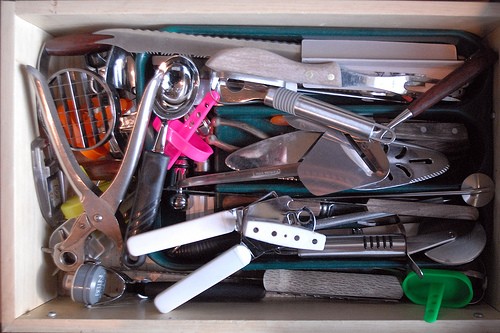
Some kitchen gadgets are useful and beloved; the humble egg slicer, for example, and the Y-shaped peeler. Some, however, are useless, or worse than useless: they cause extra work or unfortunate flavors to develop in the dish. Below are five kitchen gadgets you should extirpate from your kitchen drawers right after reading.
]
1. The Garlic Press
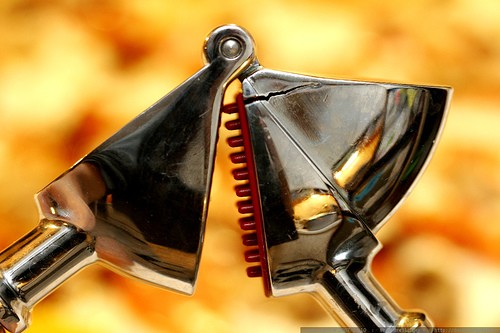
Every
stock photo of a garlic press shows perfectly minced garlic falling
neatly out of the press. What actually happens when you use a garlic
press is this: the juice runs out of the garlic all over whatever
receptacle you've used for garlic and you're left with fibrous,
unappealing flakes of garlic cellulose. When you try to sauté it in
olive oil, the juice sizzles out immediately and the flakes, no longer
plump and juicy, burn almost as quickly, lending a bitter cast to your
dish from the get-go. Then you have the joy of spending ten minutes
trying to clean the device with a pick so you don't stink up the gadget
drawer.
What to do instead: Buy a proper chef's knife and
learn to mince garlic. With practice, you should be able to reduce two
cloves of garlic into mince in under thirty seconds; twenty, if you're
skilled with a knife. If you absolutely must have garlic paste, use a
mortar, pestle, pinch of salt and thirty seconds of elbow grease.
2. The Bagel Slicer
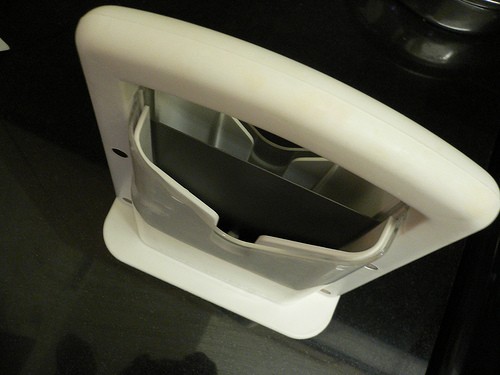
Lovingly
known as the “bagel guillotine” in offices all over the place, this
device contains a plastic sheath, into which you are supposed to insert a
bagel, and a V-shaped slicer with a handle. You plunge the slicer into
the bagel, remove it and your bagel is sliced, in theory anyway. The
bagel slicer often doesn't fit the fat, bready bagels common on the West
Coast, crushes the bagels (splitting the sides) and more than half the
time does not split the bagel the whole way through, resulting in an
unattractive tear where the bottom of the bagel resided.
What
to do instead: Buy a serrated knife. Start slowly at the top and use
gentle sawing motions until the teeth sink in, then saw the bagel in
half. It isn't any more dangerous than the protruding, serrated
arrowhead of the bagel slicer.
3.
The Flour Sifter
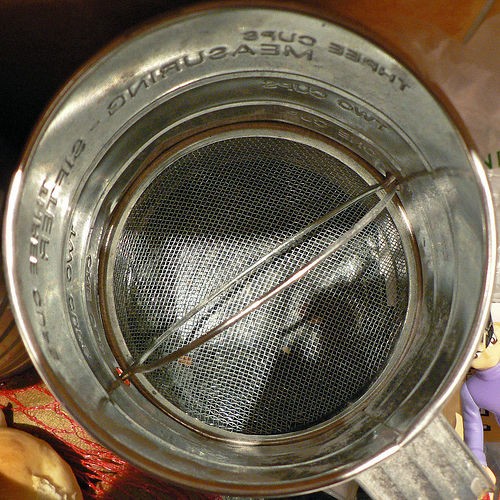
This isn't an aspersion on all flour
sifters, just the cup models with the spring-loaded handle that spins
blades located beneath the false bottom of the device. You put your dry
ingredients in, then spend a minute or so jerking the handle (and making
an annoying clacking sound), just to find out that the blades are
stuck, or it's humid and the flour has stuck, or you have filled it too
full and powdered the kitchen. Worse, because it is taller than it is
wide, it doesn't combine ingredients efficiently, which is at least half
the point of sifting multiple ingredients together in the first place.
It, too, is impossible to clean quickly, and disgusting brown wads of
dried flour end up in the un-get-attable places.
What to do
instead: Buy a handled mesh strainer of the fineness required. It's
not very much more expensive, it can serve more than one purpose (line
it with cheesecloth and you've got a ghetto chinois for straining sauces
and stocks) and there are no unreachable parts to accumulate crud.
Because strainers are wider than they are tall, it's possible to combine
disparate ingredients together with just a dozen or so smacks against
the heel of a hand.
4. The Salad Dressing Bottle
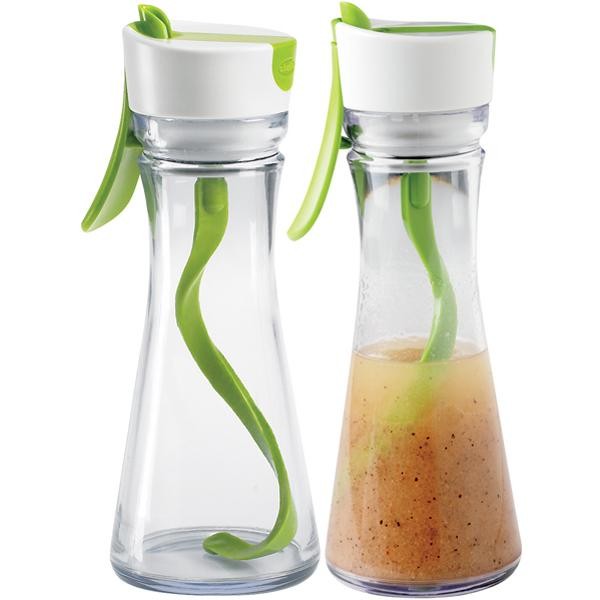
It seems like every person who shows some interest in cooking ends up
with a house full of gadgets like this one after not very many holidays.
This is a glass screw-top bottle with a lid containing a long, usually
curved blade that can be spun from the top. It claims to emulsify
dressings more efficiently. What it does is move the heaviest
ingredients together while leaving the oil in huge globs on top, while
causing hand cramps through trying to attain the appropriate velocity
using a tiny handle.
What do to instead: Take a cue from your local bartender. When a
customer orders a drink with ingredients of different viscosities that
need to be combined, the bartender shakes the drink. The same principle
can be applied to salad dressings: put the non-oil ingredients in a
small cup (snack-size disposable plastic cups work great), lid tightly,
and shake vigorously for one minute. Add the oil and shake even more
vigorously for one or two minutes, and the dressing shouldn't break for
hours.
5. The Round Metal Skewers

Skewers are skewers, you'd think; sure, some are made of bamboo and some
of metal, but other than that, they're intended to keep meat and
vegetables in line while being grilled or broiled. Round metal skewers,
however, fail at their one purpose for existing: meat spins freely on
them and tends to slip off. Some meat and vegetables, subjected to the
centripetal stress of being spun, will split rather than see their holes
enlarged. Grilling with these is nearly impossible, because flipping
the skewer doesn't flip the meat.
What to do instead: If you must have round skewers, use bamboo
instead. The grain of the bamboo provides enough friction for most meats
and vegetables not to spin as freely. Just make sure you soak them for
half an hour in water before grilling, or they'll burn to cinders and
inject ash into your food. If metal skewers are the order of the day,
try flat skewers, the kind that look like tiny swords. Meat can't turn
on them, and if you're trying to pack ground meat on (for koobideh, for
example) you will need the flatness to help you.

